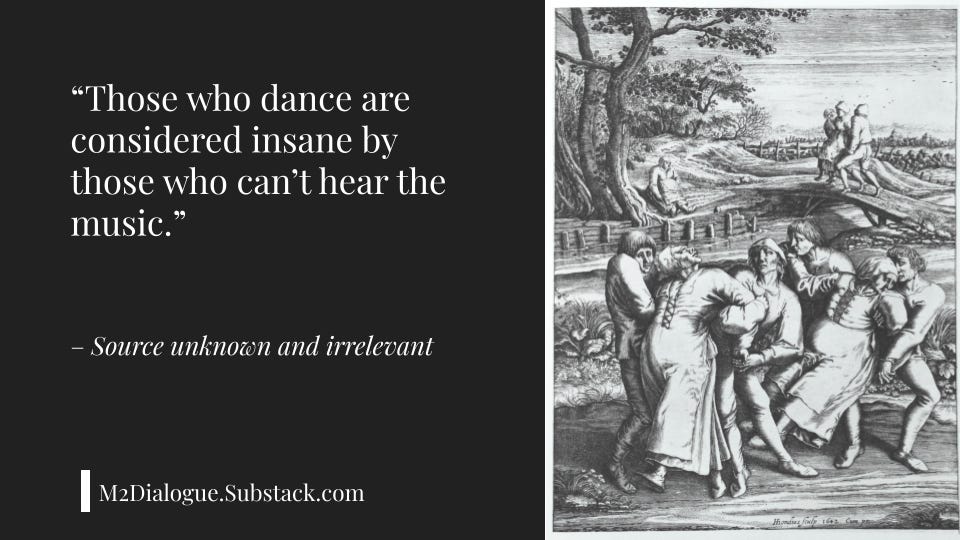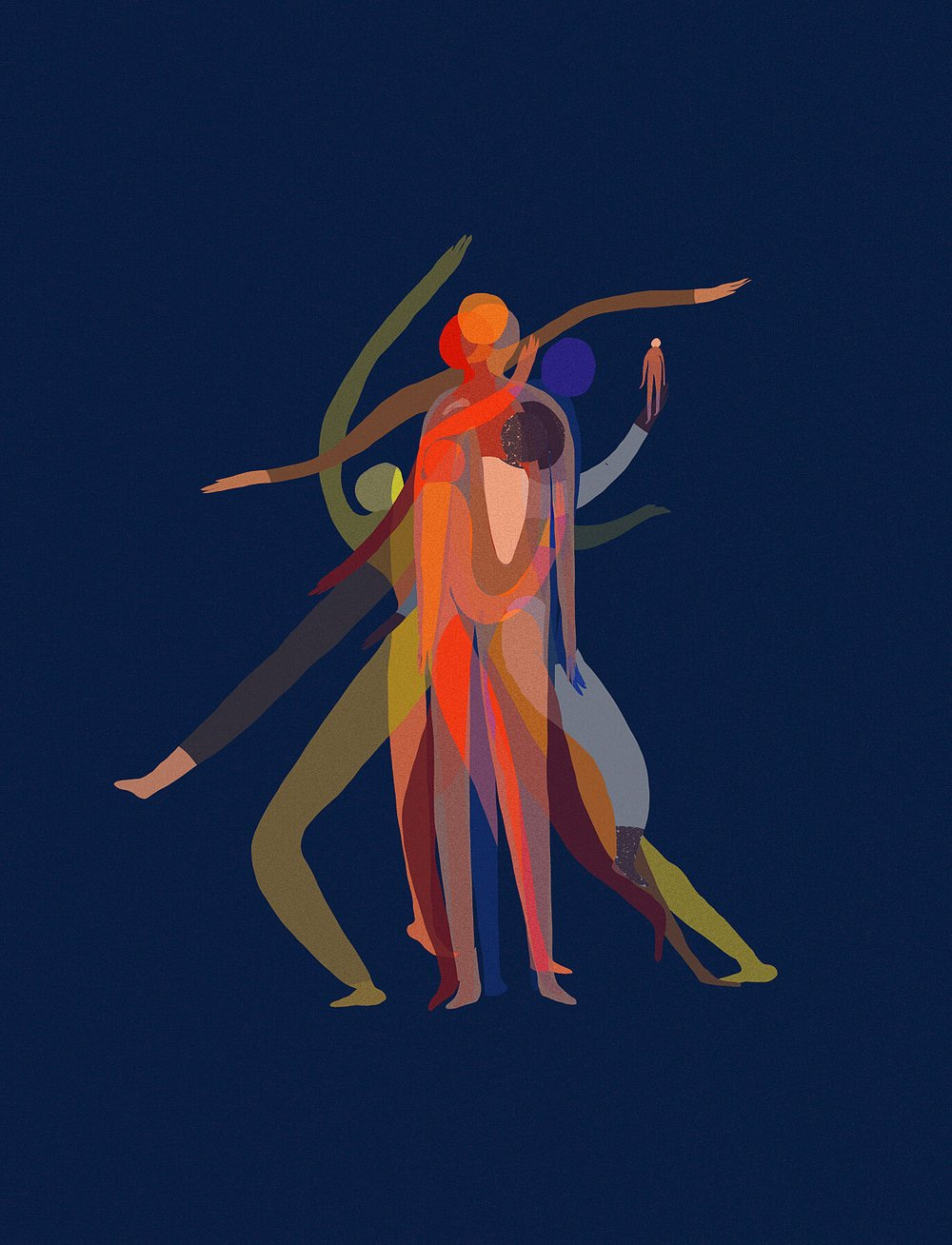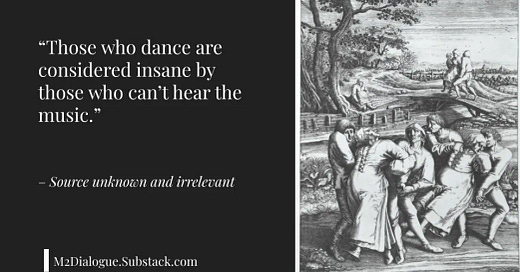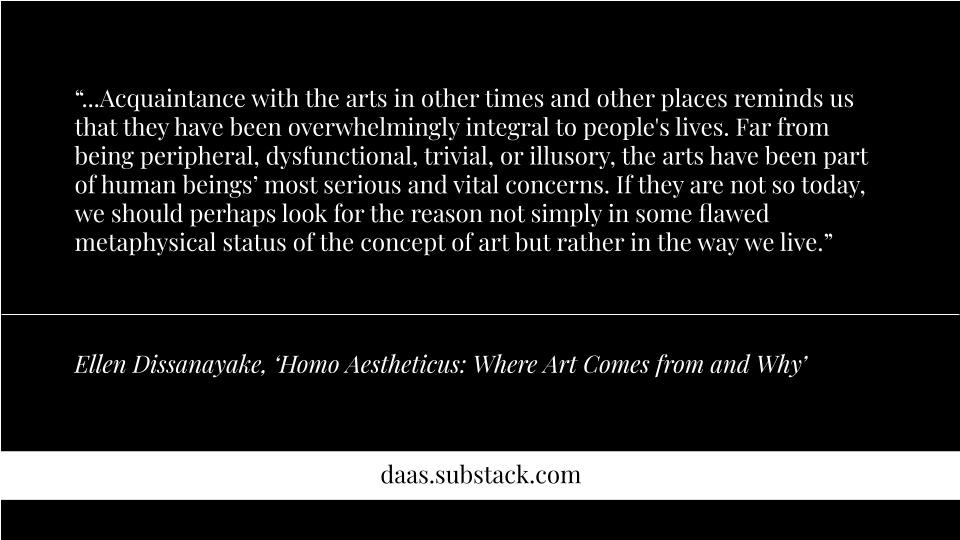Frequently Unasked Question #3
If we can't define the Age of Resonance, how do we prepare for the dance party at the end of time?
Below is my answer to Frequently Unasked Question (FUQ) #3: If we can't define the Age of Resonance, how do we prepare for the dance party at the end of time?
In response to FUQ #2, I couldn't really define the Age of Resonance, so this post is about our responses to resonances we can't define. In my view, “definitions” are suitable for the age of reason, not the age of resonance.
According to the latest estimates, there are now more than eight billion potential respondents to the Age of Resonance. There’s no reliable data about their relative sensitivity to resonance, but my experience suggests that this sensitivity varies widely, as do the responses to resonance.
When these diverse responses arise in our Tower of Babel, the prevailing state of mutual unintelligibility often causes people to pathologize ‘others’ either for responding to different resonances or for responding differently to the same resonances. Somehow, we (the eight billion of us) can't seem to find a way to honor these differences instead of lapsing into one of at least two unhelpful reactions: We either falsely interpret these differences as existential threats, or we deny the objective threats these differences pose when we don't honor them as we should. This post is an oblique exploration of alternatives to these defaults.
1. The Sound of Silence
“The material of music is sound and silence. Integrating the two is composing.” — John Milton Cage
I discovered the composer John Cage through Fourteen Variations on Silence: A Meditation on the Unheard. Here, Alina Ştefănescu “carves the unspeakable from the edge of the audible” and exposes the assumption that silence is soundless. She writes:
The idea that silence lacks harmonic structure assumes silence is soundless—a view we often impose on the deaf or hearing-disabled. To lose one’s hearing isn’t to be swept into silence but to encounter a constant private stream of percussion which no one else can share and hear.
When we puncture the myth about the soundlessness of silence, we discover the impossibility of absolute silence, which Cage illustrates with an anecdote about his visit to an anechoic chamber:
For certain engineering purposes, it is desirable to have as silent a situation as possible. Such a room is called an anechoic chamber, its six walls made of special material, a room without echoes. I entered one at Harvard University several years ago and heard two sounds, one high and one low. When I described them to the engineer in charge, he informed me that the high one was my nervous system in operation, the low one my blood in circulation. Until I die there will be sounds. And they will continue following my death. One need not fear about the future of music.
We can hear the sound of silence without visiting anechoic chambers — without even spending hours in silent meditation. We can hear the sound in John Cage's 4’33”. Don’t take my word for it. There are no guarantees in art, but if you dedicate a mere four minutes and thirty-three seconds, you can hear the sound for yourself.
2. Sound vs. Silence
“Artists are people driven by the tension between the desire to communicate and the desire to hide.” — D.W. Winnicott
Speech and silence may be equally futile, but there's a time to speak and a time to be silent, a time to publish and a time to conceal — even in defiance of futility. Nothing needs to change as a result of the alternations of speech and silence. But something inevitably changes. Vibration creates resonance.
“Everything we do is music,” John Cage once wrote. Every action, including the publication of this blog post, is a quest for resonance. Even if the resonance barely reaches beyond the author's “Audience of One”, it satisfies an irrepressible need: the need to keep looking, listening, sensing and moving.
That's why, after the discovery of the limits of language, we discover the limits of life without language. Beyond the limits of speech, we discover the limits of silence. When all is said and done, there's always more to say and do. As John Cage discovered in the anechoic chamber at Harvard, the nervous system keeps buzzing, and blood keeps coursing through the body.
John Cage as a musician and a philosopher started seeping into my mind about a year ago, and this acoustic medicine has already started to change my relationship with “noise”. In The Avatar of Avant, Cage is quoted as saying:
Wherever we are, what we hear is mostly noise. When we ignore it, it disturbs us. When we listen to it, we find it fascinating. The sound of a truck at 50 miles an hour. Static between the stations. Rain. We want to capture and control these sounds, to use them, not as sound effects but as musical instruments.
This comment felt like a response to what I had written weeks before I discovered John Cage:
The noise is part of the story because the story is, in large part, about our noisy media environment. It was already noisy when I started writing about it circa 2012. But now it's deafening.
In hindsight, I was dramatizing when I described the noise as deafening, but I was also expressing the habitual perception of noise as an intrusion into my soundscape. Recognizing noise as a feature of my soundscape helps me respond to it differently, with curiosity instead of anger or fear.
3. Responses to Resonance

“Those who dance are considered insane by those who can't hear the music.” — Source unknown and irrelevant
These responses continue until we die, but as long as we draw another breath, we continue the dance in the dialectic of sound and silence. The dance acquires an ineffable quality after the fiction of the dancer dissolves. Sometimes, this dissolution occurs before physical death, and the survivor begins to respond to life beyond ineffability.
At this stage, survivors may find their sound in the texts and practices of established traditions. They may turn to the tabernacles of Buddhism, Vedanta, Sufism, Neo-Chasiddism or another ism or the sensibilities of an avant garde movement that recognizes the dissolution of the fictive dancer.
Whether they anchor themselves in a tradition or pursue the path of self-initiation, the survivors don’t necessarily turn silent or “blissed out”. In fact, it is only after their journey past the limits of language — past the rubicon of ineffability — that they discover their true sound, their voice, their mission and their capacity for action that arises from a point of inner stillness.
The chasid may hear this intimation in the sound of the shofar or the Sh’ma. A Buddhist may hear it in the Om chant. An adherent of Vedanta may hear it through the recitation of the Pavamana mantra. Others may hear true sound through poetry, nature or psychedelics.
Even when it comes through the medium of language, True Sound doesn't come through words. Rather, we may hear the sound between the lines of a text and feel its resonance in our interiority. Then, the arrangement of words no longer matters.
This only happens “between the lines” because True Sound responds to the medium of the phonetic alphabet the way a water lily responds to its transplantation into desert sand. When it survives this entrapment, the sound resonates. I hear from sources I trust that this survival rate has been increasing exponentially, and our world is now abuzz in resonance.
We can't help but respond to resonance. In mainland Europe between the 14th and 17th centuries, these responses often took the form of dancing manias. That's my best theory of the animating energy of choreomania (aka Tarantism or the Dancing Plague).
Neither history nor science provides a satisfactory account of this phenomenon. Both history and science are language-dependent pursuits. Dance, by contrast, transcends language. It responds to resonance. It requires no explanation.
4. Homo Aestheticus
No need to explain why we do what we do. We can simply notice that, in the Platonic triad of the good, the true and the beautiful, beauty offers the surest defense against violations of truth and goodness.
I started reading Ellen Dissanayake's Homo Aestheticus: Where Art Comes from and Why, and her view of art as a biologically anchored human need reminds me of Noam Chomsky's view of language. In The Biology of Language, I annotated a 1977 interview with Chomsky where he argues that, contrary to the popular and generally unquestioned belief, language isn't taught. It isn't even learned. Instead, language grows in the mind the way physical organs grow in the body. In fact, we can regard the mind as a system of mental organs that includes the faculty of language.
Similarly, in the preface to Homo Aestheticus, Dissanayake writes:
To earlier generations, art was a divine and mysterious visitation. More recently it was demoted to a mere individual or cultural product, for example, a projected wish, according to Freudian orthodoxy, or part of the “superstructure,” as materialist philosophy would have it. Even those august modernist asthetes for whom art was supreme nevertheless described it as tangential: life-enhancing (rather than life-sustaining), in Bernhard Berenson's famous phrase, or as an alternative to or a substitutute for life. Today, it is even further detached: a representation, simulacrum, image.
Yet acquaintance with the arts in other times and other places reminds us that they have been overwhelmingly integral to people's lives. Far from being peripheral, dysfunctional, trivial, or illusory, the arts have been part of human beings’ most serious and vital concerns. If they are not so today, we should perhaps look for the reason not simply in some flawed metaphysical status of the concept of art but rather in the way we live. And I am convinced that contemporary art and contemporary life can best be regarded not from the perspective of philosophy, sociology, history, anthropology, psychology, or psychoanalysis—in their modern or postmodern forms—but within the long view of human biological evolution.
5. Beyond Definitions

In conclusion, let's return to the FUQ for this post: If we can't define the Age of Resonance, how do we prepare for the dance party at the end of time? Here are my initial thoughts:
Syntactically, the question works. It makes sense, and it points to an apparent challenge for tarantists. But notice the underlying assumption: we can only prepare for (or participate in) what we can define. Unless someone asks, I don't see the need to enumerate counter-examples.
The “dance party” I've been promoting isn't only a dance party. It welcomes all art — all media and genres through which Homo Aestheticus metabolizes the experience of beauty.
We can best prepare for the party by creating art, whether it takes the form of a dance, song, painting, or a Substack post. What's different about art created at the end of time is that it grows out of a heightened awareness of the artist as a “dancer” in the dialectic of irreconcilabilities.









